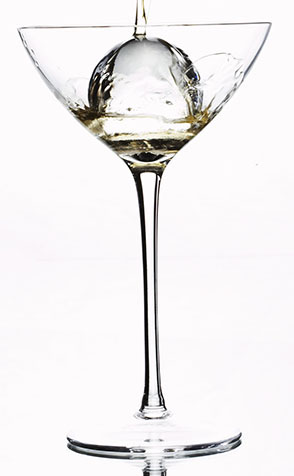Merely wrapping the Macallan 64 or Pappy Van Winkle does not complete the gift. It still needs the rocks.
 And not just any rocks will do for such special spirits. Roberto Sequeira, founder and CEO of Gläce Luxury Ice Co., has created a luxury ice that is hand-carved, melts slower and -- most importantly -- is completely tasteless, he says. That means savoring the true flavors of any fine liquors.
And not just any rocks will do for such special spirits. Roberto Sequeira, founder and CEO of Gläce Luxury Ice Co., has created a luxury ice that is hand-carved, melts slower and -- most importantly -- is completely tasteless, he says. That means savoring the true flavors of any fine liquors.
“When enjoying a 21-year old bourbon, why do we settle for the x factor?” asks Sequeira, who founded the California-based company he founded five years ago. “The quality of the ‘rocks’ is left essentially to chance, depending on the age of the water infrastructure or the maintenance of the ice machine. We wanted to create a better option, the perfect ‘on the rocks’ experience.”
Sequeira came up with the idea while working on his MBA at UCLA. As part of an assignment, he and a group of classmates were trying to “build the better mousetrap” and hit on ice as a product ripe for improvement. The industry had seen virtually no major changes since the invention of the electric refrigerator and freezer put ice cube trays in every home.
But bottled water is an $11 billion industry, according to data from the Beverage Marketing Corporation, in part because people like the taste better than what comes out of the tap. Americans consume 29 gallons per capita a year, and they choose Evian or Fiji over other brands because they enjoy those the most.
Ice, which is just frozen water, has characteristics, as well. In the late 1800s, when its use in homes became widespread following the Civil War, Lake Kennebec in Maine set the national standard for quality ice, due to its clarity, purity and taste, with a million tons of ice harvested and shipped a year in the 1880s.
Regular ice tends to melt quickly, and the smaller the cube or shaving, the faster it melts. Typically within five minutes, the ice in a drink becomes a quarter of its volume, according to Sequeira.
“The only way to perfect that drink is to have it on Gläce luxury ice,” he says.
Gläce ice is bigger, so it melts more slowly. It comes in two sizes – the 6-centimeter Mariko sphere, with a melting rate of 15-30 minutes, and the G-Cubed, whose melting rate can be as long as 40 minutes, according to the company.
Unlike a premium water like Fiji, which comes from the Fiji artesian aquifer, it is not the source of the water that makes the ice, but the methods. Gläce uses purified water, so there is no taste of chlorine and no chemicals like fluoride or traces of dozens of impurities that may be found in typical tap water, according to Sequeira. Each cube, or sphere, is carved from a 300-pound block of ice and stored in a vacuum-sealed bag so not even a tray or freezer air can taint it.
“We needed to bring literally nothing to the table,” Sequeira says. Speaking with reverence about using Gläce to chill fine spirits, he adds, “We can’t be disrespectful.”
Although ice is definitely perishable, Gläce is shipped in refrigerated trucks all over the world, as far away as France and India, within 72 hours. Once the ice arrives, it is important to put it in the freezer. Sequeira tells the story of one wealthy New Yorker who found this out the hard way, leaving the package sitting for several days until the night of a big dinner, when he then had a bag of water, although there were still a few pieces of ice floating in it.
At $325 a case – 50 pieces at $6.50 each, according to the company’s Web site, www.glaceluxuryice.com -- it’s not prudent to let the ice melt. Gläce is not trying to replace store bagged ice, but has been positioning itself as a luxury brand, Sequeira says.
“We have always known who our clients are: 5 to 10 percent of the market,” he says. “We wanted to fill a very small niche and we are very content with that.
“This is not a compulsory product. It’s one of those earned luxuries.”
The holiday season tends to be busier for Gläce, with greater demand for parties and gift-giving. But Sequeira said the ice also has become a mainstay at top-of-the-line weddings, in vacation homes, on yachts and private jets.
“There’s really no down season,” says Sequeira, then adding, “Maybe the week after New Year’s.”
For Some, Fine Liquor Deserves Fine Ice
December 17, 2013
« Previous Article
| Next Article »
Login in order to post a comment








